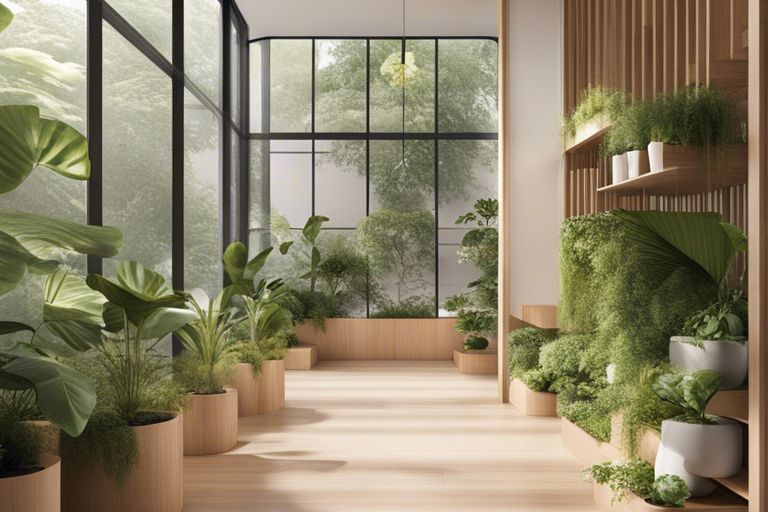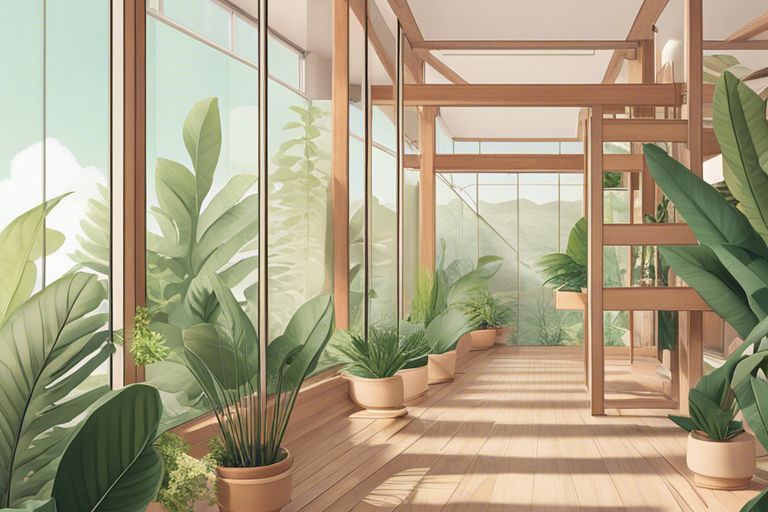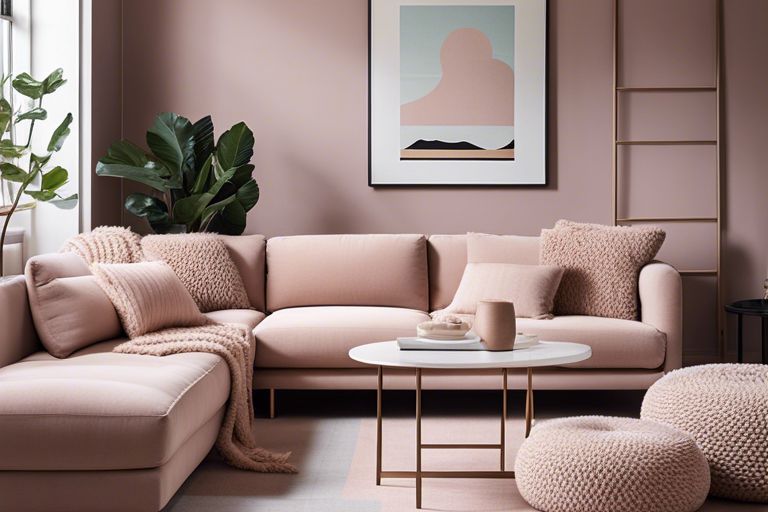There’s a way to improve the air quality in your home or workspace by incorporating biophilic design elements. By adding elements like plants, natural light, and natural materials into your surroundings, you can enhance the air you breathe. Let’s explore how these biophilic design elements can benefit your health and well-being.
Key Takeaways:
- Biophilic Design: Integrating natural elements such as plants, natural light, and ventilation systems can significantly improve indoor air quality.
- Air Purifying Plants: Including specific plants like peace lilies, spider plants, and snake plants can help remove toxins and pollutants from the air, promoting a healthier environment.
- Natural Ventilation: Incorporating design elements that allow for proper airflow, such as operable windows and atriums, can enhance air circulation and quality within indoor spaces.
The Importance of Air Quality
To truly understand the significance of air quality, you must first recognize the profound impact it has on your overall health and well-being. The air you breathe directly affects your respiratory system, cardiovascular health, and even your mental clarity. Poor air quality can lead to a variety of health issues, ranging from minor irritations to serious respiratory illnesses.
The Impact of Poor Air Quality on Human Health
Quality air is crucial for your body to function optimally. When the air around you is polluted with harmful particles and toxins, your respiratory system becomes compromised. This can result in increased instances of asthma, allergies, respiratory infections, and even long-term lung damage. Additionally, poor air quality has been linked to heart disease, stroke, and other serious cardiovascular conditions.
The Economic Costs of Air Pollution
Costs associated with air pollution extend far beyond personal health concerns. The economic implications of poor air quality are staggering. From increased healthcare costs to lost productivity in the workforce, air pollution takes a significant toll on society as a whole. The long-term effects of air pollution can burden healthcare systems, contribute to higher rates of absenteeism at work, and hinder economic growth.
Economic studies have shown that investing in measures to improve air quality can lead to substantial cost savings in healthcare expenditures and increased productivity in the workforce. By prioritizing clean air initiatives and implementing biophilic design elements to enhance indoor air quality, not only can you protect your health and well-being, but you can also contribute to a healthier, more prosperous society.

Biophilic Design Elements
Definition and Principles of Biophilic Design
Designing with biophilic elements involves incorporating natural features, materials, and views into indoor spaces to reconnect individuals with nature. This design approach is based on the principle that humans have an innate need to be connected with the natural world. By integrating elements like plants, natural light, water features, and natural textures, biophilic design aims to create environments that promote well-being and boost productivity.
Examples of Biophilic Design in Architecture
An example of biophilic design in architecture is the use of large windows that provide panoramic views of green spaces, allowing abundant natural light to flood the interior spaces. This not only enhances the aesthetic appeal of the building but also connects occupants with the outdoors, fostering a sense of calm and tranquility. Another example is incorporating living walls or vertical gardens within buildings, which not only improve air quality but also create a sense of biophilia by bringing nature indoors.
Examples of biophilic design elements also include the use of natural materials such as wood, stone, and bamboo to create a sense of warmth and simplicity in interior spaces. These materials not only add a touch of nature to the environment but also help maintain indoor air quality by reducing harmful chemicals often emitted by synthetic materials.
Natural Ventilation Strategies
Despite the convenience of air conditioning systems, there are more natural ways to improve the air quality in your space. Implementing natural ventilation strategies can significantly enhance the quality of the air you breathe indoors.
Benefits of Natural Ventilation
With natural ventilation, you can reduce the concentration of indoor air pollutants that can be harmful to your health. Fresh air from the outdoors helps dilute pollutants such as volatile organic compounds (VOCs) and improves overall indoor air quality. Additionally, natural ventilation can lower energy costs by reducing the need for mechanical cooling systems.
Designing for Natural Ventilation
Ventilation design plays a crucial role in maximizing the benefits of natural ventilation. Strategically placing windows and vents to allow for cross ventilation can promote airflow throughout the space. Consider the orientation of your building to take advantage of prevailing winds and create natural airflow pathways.
Ventilation
When designing for natural ventilation, it’s imperative to consider the impact of local climate on airflow patterns. Understanding wind directions and outdoor air quality can help you optimize ventilation strategies for your specific location. By incorporating operable windows and vents in your design, you can have more control over the amount of fresh air circulating in your space.
Air Purification Systems
After reading about how Biophilic Design Makes Economic Sense Once You Look …, you might be wondering about the practical applications of incorporating biophilic design elements into your indoor spaces. One crucial aspect to consider is the installation of air purification systems to improve indoor air quality and create a healthier environment for you and your loved ones.
Types of Air Purification Systems
One of the most common types of air purification systems is the High Efficiency Particulate Air (HEPA) filter, which can capture particles as small as 0.3 microns in size. Other types include activated carbon filters, UV germicidal irradiation, ionizers, and ozone generators. Each of these systems has its strengths and weaknesses, so it is imperative to choose the one that best suits your needs. THough, keep in mind to consider factors like the size of the space, existing air quality issues, and maintenance requirements when selecting an air purification system.
| High Efficiency Particulate Air (HEPA) filter | Effective in capturing particles as small as 0.3 microns |
| Activated carbon filters | Effective in removing odors and volatile organic compounds |
| UV germicidal irradiation | Kills bacteria and viruses |
| Ionizers | Release negative ions to attract airborne particles |
| Ozone generators | Produce ozone to neutralize odors and kill bacteria |
Effectiveness of Air Purification Systems
Types of air purification systems vary in their effectiveness in removing different types of pollutants from the air. It is imperative to understand that while some systems may be excellent at removing particulate matter, others excel at eliminating odors or killing bacteria and viruses. By selecting the right air purification system based on your specific needs, you can significantly improve the indoor air quality in your space.
Understanding the efficacy of each air purification system can help you make an informed decision and choose the best option for your indoor environment. Remember to consider factors such as maintenance requirements, energy consumption, and the types of pollutants present in your space when selecting an air purification system.
Green Walls and Living Walls
How Green Walls Improve Air Quality
Many indoor spaces suffer from poor air quality due to the accumulation of pollutants like volatile organic compounds (VOCs) emitted from furniture, cleaning products, and even building materials. Green walls, also known as living walls, can significantly improve the air quality in these spaces by acting as natural air filters. The plants in green walls absorb these pollutants through their leaves and roots, helping to purify the air and create a healthier environment for you to breathe in.
Design Considerations for Green Walls
Any successful design of green walls should take into account several important factors to ensure optimal functionality and visual appeal. Walls must be structurally sound and equipped with proper irrigation systems to support the growth of plants. The selection of plant species is crucial as well, as some plants are more effective at filtering out pollutants than others. Additionally, the positioning of the green walls within the space plays a key role in their overall impact on air quality.
With proper maintenance and care, green walls can thrive and continue to enhance the air quality of your indoor environment. Regular monitoring of the plants’ health and irrigation levels is imperative to sustain their effectiveness in purifying the air. By incorporating green walls into your biophilic design, you not only improve the aesthetics of your space but also prioritize your health and well-being.
Material Selection for Better Air Quality
Low-VOC Materials and Their Benefits
Material selection plays a crucial role in ensuring better air quality in indoor spaces. Your choice of materials can impact the levels of volatile organic compounds (VOCs) present in the air. VOCs are harmful chemicals that off-gas from certain building materials and furnishings, contributing to indoor air pollution. Opting for low-VOC materials, such as paint, adhesives, and sealants, can significantly reduce the release of these toxic substances into the air.
Sustainable Material Options for Indoor Spaces
With respect to improving indoor air quality, choosing sustainable materials is key. Material options like bamboo, reclaimed wood, and recycled glass not only help reduce the environmental impact of your space but also contribute to better air quality. These materials are often produced using eco-friendly processes and have strong indoor air quality credentials, making them safer choices for your health and well-being.
Better yet, sustainable materials are durable and long-lasting, ensuring that your indoor environment remains healthy and free of harmful pollutants for years to come. By incorporating these sustainable options into your design, you can create a space that not only looks good but also promotes a healthier indoor environment for you and your loved ones.
Implementing Biophilic Design in Practice
Unlike traditional design approaches, integrating biophilic elements into your space can pose both challenges and opportunities.
Challenges and Opportunities in Biophilic Design
With biophilic design, some challenges may include the initial cost of incorporating natural elements, as well as the need for maintenance to ensure the vitality of plants. However, the opportunities are vast, such as improved air quality, enhanced well-being, and increased productivity for occupants.
Success Stories of Biophilic Design in Buildings
For buildings that have successfully implemented biophilic design, the results speak for themselves. Improved indoor air quality, reduced stress levels, and increased connection to nature are just a few of the benefits reported by occupants.
Buildings that prioritize biophilic design elements not only benefit the people who occupy them but also contribute to a healthier environment overall. By incorporating elements such as indoor plants, natural light, and green walls, these spaces become healthier and more inviting for everyone.
Conclusion
With these considerations in mind, you can see how implementing biophilic design elements in your space can significantly improve air quality, promote well-being, and increase productivity. By incorporating elements such as natural lighting, indoor plants, and natural materials, you can create a healthier and more harmonious environment for yourself and those around you.
Just as Rachel Carson’s writing brought attention to the importance of environmental conservation, your choice to embrace biophilic design can make a positive impact on both your health and the planet. So, take a step towards a cleaner and fresher atmosphere by incorporating biophilic design elements into your space and breathe easy knowing you are contributing to a healthier environment.
FAQ
Q: What is biophilic design?
A: Biophilic design is an innovative approach to architecture and interior design that incorporates elements of nature to create a healthier and more harmonious environment for occupants.
Q: How can biophilic design improve air quality?
A: Biophilic design elements such as green walls, natural ventilation systems, and indoor plants can help to filter out pollutants and increase oxygen levels, thereby improving indoor air quality.
Q: What are some examples of biophilic design elements that can be incorporated into a space?
A: Examples of biophilic design elements include living walls, daylighting systems, water features, natural materials like wood and stone, and views of nature through windows or skylights.



